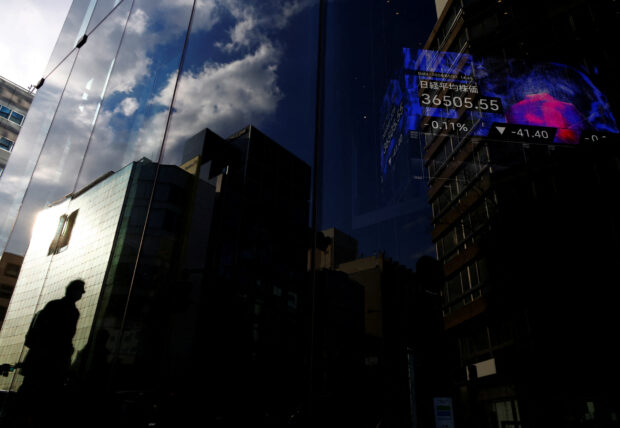
A pedestrian is reflected on a glass of a business building while an electric board showing Nikkei index is seen in the building at a business district in Tokyo, Japan Jan 23, 2024. REUTERS/Kim Kyung-Hoon/File photo
SINGAPORE —Asian shares struggled to advance on Tuesday, with slightly warmer-than-expected Japanese inflation putting investors on guard ahead of price data due in Europe and the U.S. this week.
The yen steadied at 150.57 to the dollar and inched off a three-month low on the euro as Japanese inflation stayed at the central bank’s 2 percent year-on-year target, keeping alive expectations it would exit negative rates by April.
READ: Japan’s inflation beats forecasts, end of negative rates still in sight
Tokyo’s Nikkei crept 0.4 percent higher to eke a fresh record high. MSCI’s broadest index of Asia-Pacific shares outside Japan was flat, keeping beneath last week’s seven-month peak.
Wall Street indexes fell overnight and S&P 500 and Nasdaq futures nudged 0.1 percent lower in morning trade.
The Federal Reserve’s favored measure of inflation – the core personal consumption expenditures (PCE) price index – is due on Thursday and forecasts are for a rise of 0.4 percent.
READ: Equities close slightly lower as focus shifts to data
“If as expected, the core m/m reading would be the highest since last February and fit with the patience message from the Fed,” said analysts at ANZ Bank.
Rate jitters and enormous auctions – $127 billion on Tuesday and another $42 billion on Wednesday – left Treasuries under pressure, though yields steadied in the Asia morning.
Ten-year U.S. Treasury yields were last 2 basis points lower at 4.27 percent. Two-year yields fell four basis points to 4.7 percent.
Rate jitters
Markets have already pushed out the likely timing of a first Federal Reserve easing from May to June, which is currently priced at around a 70 percent probability. Futures imply a little more than three quarter-point cuts this year, compared to five at the start of the month.
On the geopolitical front, U.S. President Joe Biden said he hopes to have a ceasefire in the Israel-Hamas conflict in Gaza start by next Monday as the warring parties appeared to close in on a deal.
Brent crude futures kept to recent ranges, rising 0.2 percent or 16 cents to $82.69 a barrel.
Figures on inflation in the European Union are also due this week, on Friday, with the core gauge again seen slowing to the lowest since early 2022 at 2.9 percent and bringing nearer the day when the European Central Bank (ECB) might ease policy.
Markets are almost fully priced for a first cut in June, with April seen as a 36-percent chance. In speeches on Monday, ECB President Christine Lagarde and Bank of Greece Governor Yannis Stournaras again pointed to a reticence to rush in to cuts.
Consumer confidence
Bank of England Deputy Dave Ramsden and Riksbank Governor Erik Thedeen appear later on Tuesday while a smattering of mostly second-tier U.S. and European data are due including consumer confidence for Germany, France and the U.S.
Currency trade was fairly subdued in early Asian hours, with recent pressure on the Australian and New Zealand dollars extending. The Aussie fell 0.1 percent to a one-week low of $0.6530, squeezed by a tumble in iron ore prices.
The kiwi was down 0.3 percent and also at a week low as traders trimmed wagers that New Zealand’s central bank might even hike interest rates when it meets on Wednesday.
“With 9 bp priced, we see modest NZD weakness on the announcement,” said NatWest Markets currency strategist Antony George.
The euro held steady at $1.0848 and sterling inched down to $1.2676. Bitcoin rose sharply overnight on news that software firm MicroStrategy added to its holdings. It was steady at $54,777. Gold held at $2,032 an ounce.